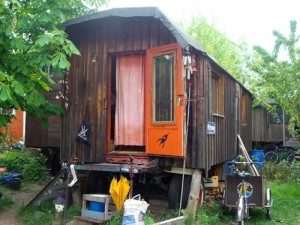by Ayesha Adamo

Even before I got to Berlin, I couldn’t wait to go and explore the wagon community called Lohmühle that I read about on my Internet explorations.
For a gal who has never been to Berlin before, and was functioning entirely on tea-stained tourist maps, this place was not so easy to find. The Kotbusser Tor U-Bahn stop in Kreuzberg is probably the closest, though there’s still a bit of a walk ahead from there. It’s kind of in the middle of a park, so the roads I was expecting to take to get there were all wrong. I ended up just aiming for the general direction and suddenly the wagons appeared like a mirage on the opposite side of a canal.
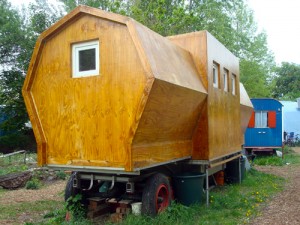
Wagons!
When I finally figured out how to cross the canal and get to the wagons, I could already hear the sound of easy retro records sliding between the two turntables that were perched centerstage. There were posters up for upcoming events and shows, one for a performance of Macbeth that had unfortunately passed already. I threw several euros into the bake sale donation cup for a slice of vegan marble cake; the chocolaty part was better than the vegan part, to my semi-carnivorous palate, but the vibe was compensation enough for no eggs.

The people who live here have decided to name this community the “Gesamtkunstwerk” meaning a total artwork that involves many different artistic disciplines. The term was popularized by Wagner in his essay, “Art and Revolution,” and there’s clearly plenty of both here. Walking through Lohmühle, every home is a vibrant expression of Art, and of the part of daily living that is Art - both contributing to what has become a social public space. The Lohmühle folks are technically squatting on public land but have created a place where anyone is welcome to wander through and visit, enjoy the open-air café, music, and the regular outdoor movies in the summer, among other events. Proceeds from the events go to funding of the Lohmühle community and to charitable groups beyond the community. Also, when building the
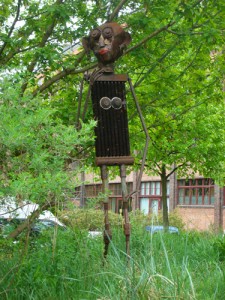
café, gallery, and stage areas of the grounds, the residents invited the rest of their neighborhood to join in, again making it a project that extends beyond the community wagon-dwellers themselves. Here, the total work of art has become a total work of connection between these brave artisans and their neighbors. The result of this ultimately functions as an alternative culture center that people from anywhere in Berlin – and even people from as far away as America – can enjoy.
I circled the grounds several times, mostly wishing I could speak more German so that I would feel less shy about jumping into one of the clusters of tea and conversation that seemed to blossom in rings of chairs outside the wagons. Some were talking government in earnest, but I felt like an interruption from a foreign-speaking stranger might disperse the bubble of their intensity, not that I wasn’t interested in what the people with pink and aqua anarchy symbols spray-painted on the side of their wagons would have to say.
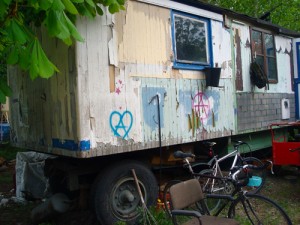
I did get to speak to one of the residents who was tending bar at the café. He’s lived in the Wagendorf for 6 years, but is soon to move out to travel the world. Outside of the Gesamtkunstwerk, he works in physical therapy, I think, and from the sound of it, world travel is the only reason for him to want to give up his life with the wagons.
With the huge emphasis and basic need for community here (the winters are clearly not to be braved alone), those in residence seem to place a high value on creating a lifestyle outside of the anonymity of living box-to-box in urban apartments. Face-time appears to be the preferred mode of operations.
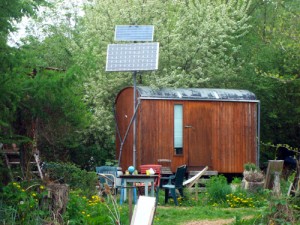
Environmental awareness also presents itself - not just in the way that the Wagendorf folks have blended their community into the environment, but in the group’s ideals concerning conservation of resources – ideals that are visibly practiced and not just spoken about. All of the wagons make heavy use of solar panels, and their residents are clearly conservative of water since there is no running water here.
I told the boy at the café that we don’t have anything like this in New York, though the Sanctuary in Brooklyn, which has come to be a sanctuary to me at times, shares some of the same ideals. For certain, there are others in the New York area who are working in this direction, though in New York it’s hard to
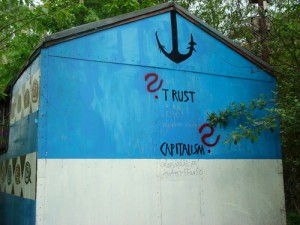
even imagine doing what they’ve done at Lohmühle. The idea of creating a squatting community that is essentially illegal but has been accepted for long enough that it may become legal seems an impossibility in the Five Boroughs, or any other American city I can think of. And that’s what has been going on successfully at Lohmühle for nearly twenty years now.
Here is a link to the Lohmühle website, though you may want to use Google translate to get a better idea of it in English:
http://www.lohmuehle-berlin.de/LM_home.htm
Another site that has a couple of great pictures of what the Wagendorf looked like when it was the dividing line between East and West Berlin is this one (in English):
http://www.a-r-d.org/HamburgerB/Lohmuhle.htm
